
New York: The protesters occupying Hamilton Hall on the campus of Columbia University seemed ready to stay awhile.
They had a microwave, an electric teakettle and sleeping bags, images distributed by police show. On a blackboard in a classroom-turned canteen, next to the words “Free Palestine” in bubble letters, they had written a chart for occupiers to list their dietary restrictions (two were vegan, one vegetarian).
In another classroom, they made a chart for security duties in two-hour shifts, and listed three Maoist revolutionary slogans as inspiration, according to the police videos.
“Political power comes from the barrel of a gun,” one of the slogans said.
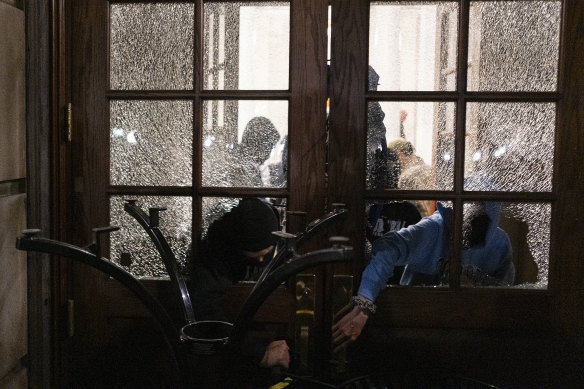
Students with the Gaza Solidarity Encampment block the entrance of Hamilton Hall.Credit: AP
For two weeks, Columbia’s campus had been the focal point of a growing crisis on college campuses around the country. Pro-Palestinian demonstrators set up tent encampments, held rallies and otherwise attempted to disrupt academic activities in an attempt to force universities to meet several demands, including divesting from Israel.
But the takeover of Hamilton Hall was a new turning point. The university decided to call in police to clear the building - drawing both harsh criticism and praise, and raising new questions about who, exactly, was behind the growing unrest.
The people who took over the building were an offshoot of a larger group of protesters who had been camping out on campus in an unauthorised pro-Palestinian demonstration. On Tuesday night, more than 100 of them – people inside the hall along with others outside on campus and those beyond Columbia’s gates – were arrested.
In the days since, Mayor Eric Adams, police officials and university administrators have justified the arrests in part by saying that the students were guided by “outside agitators,” as the mayor put it. “There is a movement to radicalise young people, and I’m not going to wait until it’s done and all of a sudden acknowledge the existence of it,” he said on Monday.
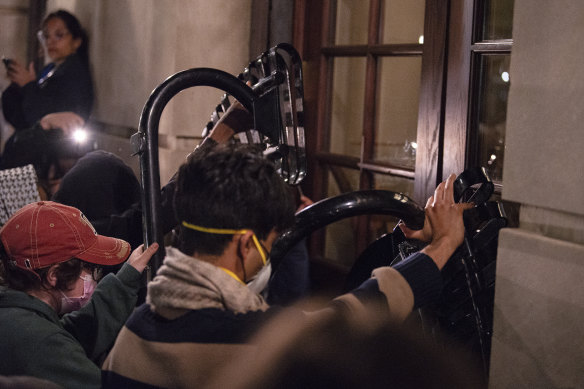
Students with the Gaza solidarity encampment block the entrance of Hamilton Hall.Credit: AP
In an interview, Adams said that 40 per cent of people arrested after the protest at Columbia and another that night at City College “were not from the school and they were outsiders”.
But at Columbia, at least, the percentages appeared to be lower, according to an initial analysis of police data by The New York Times.
On Thursday, Adams and Edward A. Caban, the police commissioner, released a statement saying that of the 112 people arrested at Columbia, 29 per cent were not affiliated with the school. That percentage was similar to the findings of a Times analysis of a Police Department list of people who were arrested that night.
At City College, north of Columbia in Manhattan, 170 individuals were arrested, and about 60 per cent of them were not affiliated with the school, the statement said.
According to the Times analysis, most of those arrested on and around Columbia’s campus appeared to be graduate students, undergraduates or people otherwise affiliated with the school.
At least a few, however, appeared to have no connection to the university, according to the Times′ review of the list. One was a 40-year-old man who had been arrested at anti-government protests around the country, according to a different internal police document. His role in the organisation of the protest is still unclear.
The day after New York City police officers stormed into the building through a second-floor window and rooted out the protesters from Hamilton Hall, new details emerged about both the takeover of the building and the operation to reclaim it. The details revealed a 17-hour-long student occupation that was both destructive and damaging to property, amateurish, but in some respects, carefully organised.
The Police Department list showed that most of the more than 100 people arrested in the sweep of Hamilton Hall and other parts of campus on Tuesday evening were in their late 20s, white and female. The average age was 27; more than half were women.
The records do not specify which people were arrested inside the building. But at least 34 taken into custody on or around the campus were charged with burglary, which is defined by New York law as unlawfully entering a building with intent to commit a crime.
As of Thursday afternoon, at least 14 people who had occupied Hamilton Hall and later been arrested appeared in Manhattan Criminal Court. All were charged with trespassing, a misdemeanour.
The occupation began early Tuesday morning, after a group of protesters decided to escalate their efforts to force Columbia to divest from companies supporting Israel.
As hundreds of protesters gathered around Columbia’s central campus, forming a picket, a smaller group carried tents to a lawn on the opposite end of campus from Hamilton Hall, apparently to create a diversion, several witnesses said. At the same time, a second set of protesters approached the building.
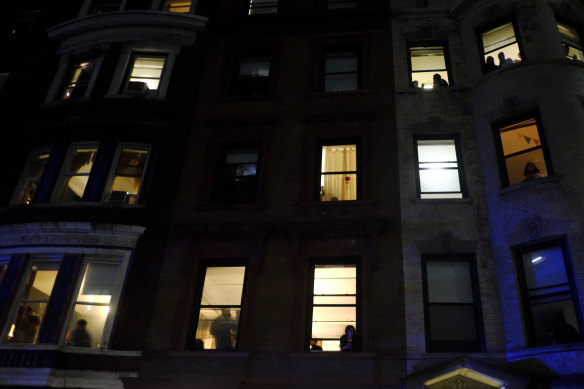
ir residence hall windows as members of the New York Police Department strategic response team move towards an entrance.Credit: AP
A protester who had been hiding in the building after it closed let the others in, according to Columbia officials. Those protesters entered and told the security guard there to leave, said Alex Kent, a photojournalist who entered with them. They then began the process of bringing in supplies and barricading themselves in.
Some of the demonstrators wore Columbia sweatshirts; others wore all black. They also wore gloves, and masks around their faces. They hauled in metal police barricades to help reinforce the doors against entry, according to images shot by Kent.
Kent and the police said that the protesters covered security cameras, and threaded heavy metal chains through windows they had smashed in the building’s French-style doors, securing them with bicycle locks. Protesters carried wooden desks and tables from classrooms to help reinforce the doors. They joined the pieces of furniture together with white plastic ties to make them harder to move, police images show. They secured another door with a vending machine.
They got into a shoving match, Kent said, with a facilities worker who was still in the building, but the worker ultimately left. Outside, a career protest organiser in her 60s, Lisa Fithian — whom Adams later labelled a “professional agitator”— tried to talk down two student counterprotesters who were blocking the throng from further barricading the entrance. The protesters tried to physically remove the two students, who ultimately walked away; Fithian was not arrested.
Police officials had been in regular conversations with Columbia for weeks about how to handle the increasingly entrenched student encampment. Now, university officials were in crisis mode.
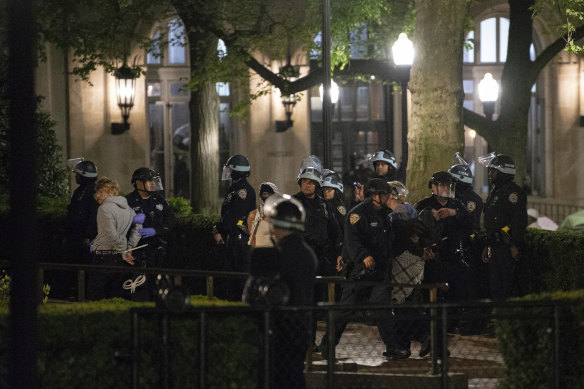
New York police arrest pro-Palestinian protesters who occupied the administration building at Columbia University this week.Credit: AP
The school’s leadership team, including the board of trustees, met throughout the night and into the early morning, consulting with security experts and law enforcement, Minouche Shafik, Columbia’s president, wrote in a letter to the community.
“We made the decision, early in the morning, that this was a law enforcement matter, and that the NYPD were best positioned to determine and execute an appropriate response,” she wrote.
Once police got that call sometime after 11 am, “We had to put together a plan fast,” according to Jeffrey Maddrey, the chief of department, who described the police response during a news conference the day after the arrests.
On Amsterdam Avenue, outside Hamilton Hall, police brought in a BearCat truck equipped with an extendible ramp, so that officers could bypass the barricaded front doors and climb into an upper-story window.
Just after 9:30 pm, a group of officers in riot gear began lining up and then balancing across the BearCat’s platform, one by one. Once inside, police said, some students started throwing things at them.
Maddrey said police decided to deploy “distraction devices”— commonly called “flash-bangs” or stun grenades - that produce a very strong noise and burst of light to temporarily disorient people’s senses. At least eight loud bangs were heard echoing on footage from a police body camera.
Another team of officers entered through the building’s front doors, cutting the metal chains and rapidly dismantling the items blocking the entryway, the body camera video showed.
While city officials praised police for what they said was restraint in clearing the campus, protesters said some officers at the scene had been aggressive with demonstrators.
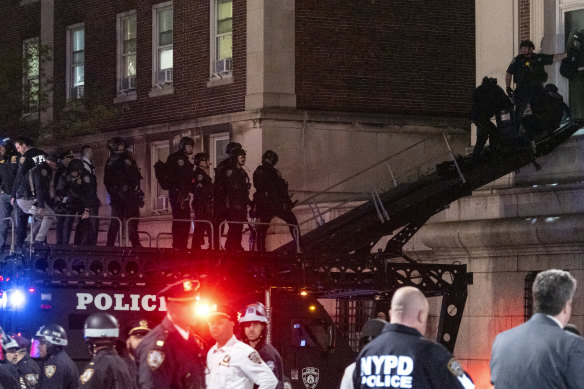
Using a tactical vehicle, New York City police enter an upper floor of Hamilton Hall on the Columbia University campus in New York after it was taken over by protesters.Credit: AP
Protesters and independent journalists posted videos that appeared to show police officers pushing and dragging demonstrators outside Hamilton Hall’s main entrance during the arrests. The Columbia Spectator reported that outside Hamilton, officers threw protesters to the ground and slammed into them with metal barricades. Most journalists had been required by police to leave the area and could not document the scene.
“Students were shoved and pushed,” said Cameron Jones, a student in Columbia’s Jewish Voice for Peace chapter, who was watching from a nearby building. One protester lay motionless for several minutes, and was zip-tied while in that position, Jones said, before she came to and was carried away by police.
“It really seems as though the university, the police and Eric Adams are just trying to save face and not acknowledge the police brutality that happened on our campus,” he said.
Adams said there had been “no injuries or violent clashes” and the Fire Department said no one in Columbia’s immediate vicinity had been transported to the hospital.
During the sweep of Hamilton Hall, one officer fired a single gunshot, according to Doug Cohen, a press secretary for the Manhattan district attorney. No one was struck, and no students were in the area when the shot was fired. It was not clear whether the shot was fired intentionally.
The charges against those arrested ranged from burglary, trespassing and disorderly conduct to criminal mischief, resisting arrest and obstructing governmental administration. More than half of the people arrested at Columbia — those facing less serious charges — were issued summonses and released, or issued appearance tickets. The remaining 46 were arraigned and released without bail.
Some of those arrested at City College were students who had built an encampment earlier in the week in a plaza on the school’s campus.
But they also included people who had joined a protest outside the campus’s locked gates, on a public sidewalk. Many of the people on the police list arrested near City College appeared to be unaffiliated with the school.
Loading
On the list of protesters arrested at or near Columbia were a handful of people without clear ties to the university, including one man who apparently lives in the neighbourhood and who was arrested outside, and a woman who describes herself online as a “poet and farmer” who went to college in Vermont.
Attempts to reach several of the protesters on the list were unsuccessful as of Thursday afternoon.
Columbia students received more news Wednesday that their semester would not be returning to normal.
While classes had already ended Monday, the school announced that all final exams and academic activities on the Morningside Heights campus would be fully remote for the rest of the semester.
“It is going to take time to heal, but I know we can do that together,” Shafik wrote.
This article originally appeared in The New York Times.
Get a note directly from our foreign correspondents on what’s making headlines around the world. Sign up for the weekly What in the World newsletter here.



























